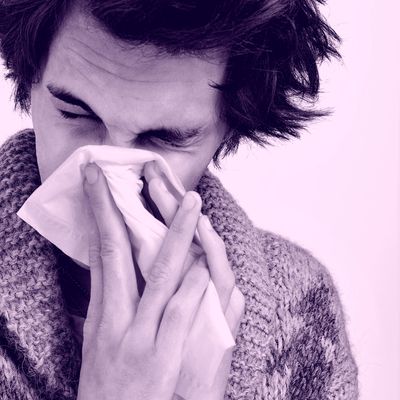
Dear Mona,
I have awful seasonal allergies, which means I have been a sneezy, watery-eyed mess for weeks. My partner, on the other hand, has sailed through the late spring and early summer with hardly an achoo. Is there any data to tell us the type of people who are more likely to get hay fever? I would like to know more about my comrades in misery.
Thanks,
A., 34
Dear A.,
I’m not surprised this question landed in my inbox when it did — for the past decade, Google searches for the word “allergies” have spiked at this time of year, regular as clockwork. The U.S. is responsible for more of those searches than any other country (especially in New Mexico, Kentucky, and Oklahoma) but since Google doesn’t share actual traffic numbers, I’ve got to look elsewhere to find out how many people actually suffer from seasonal allergies. After all, just because people are searching the web for the term doesn’t necessarily mean they have allergies. (I’ve Googled “micropenis” more times than I care to remember — all part of the job, A. — and that doesn’t necessarily mean I’ve got one.)
What I’ve discovered is that the number of Americans with seasonal allergies is huge (and looks set to rise even further) but that not everyone is equally susceptible to watery eyes and incessant sneezing for a few months every year. As it turns out, your age and even your race affect the chances that you’ll have hay fever.
The latest numbers from the Centers for Disease Control and Prevention (CDC) were published in 2014, and they show that 19.1 million U.S. adults had hay fever (7.7 percent of all adults) as well as 6.1 million kids (8.4 percent of everyone under 18). But here’s something interesting: They collected that data by asking if respondents “had been told by a doctor or other health professional in the past 12 months that they had hay fever.” That means that these numbers could be cautiously at the lower end of estimating prevalence. I don’t know about you, but I’ve never had a doctor tell me I have hay fever; I just bought some Claritin from the pharmacy and tried to get back to work.
Responses to that same survey question are broken down by demographics, so I can tell you that the age group most likely to have had hay fever diagnosed is 12–17 years old — 11.7 percent of everyone in that age group experienced it in the year to 2014, while rates drop to 5.6 percent between the ages of 18 and 44.
Allergies by age
There are a bunch of different theories as to why hay fever is so prevalent in kids. In 2013, an analysis of 8,023 European children found that growing up in a large family or with exposure to a farming environment “markedly reduce the prevalence of hay fever.” A global study in 2014 based on over half a million kids confirmed that sibling numbers can affect the chances of hay fever (more siblings means lower risk) but it found that trend was “mainly a phenomenon of more affluent countries.” Since farming is declining in the U.S. and women in the U.S.have, on average, two children over the course of their lifetimes, perhaps it’s no wonder that hay fever among children is so prevalent. Lastly, if parents have hay fever, their children are more likely to have it, too.
If you’re a white American, the chances you’ll have hay fever are a little higher — 8.5 percent of all white U.S. adults were diagnosed with seasonal allergies in the year to 2014 compared to around 6 percent of Americans who were black, Asian, or Hispanic. The only other group to have similarly high hay fever rates were the 8.1 percent of American Indians or Alaska Natives who were also diagnosed with it.
Allergies by race
To understand why allergy rates vary by race, it’s important to look at other information published by the CDC — namely the tables on education status and income. The better educated and wealthier an American is, the higher the probability that they will have hay fever. And, if you haven’t guessed it already, white Americans are still more likely to have finished high school or college and have higher incomes than black or Hispanic Americans.
But what would education possibly have to do with whether or not a person has seasonal allergies? Besides, this point doesn’t hold up when you consider that Asian-Americans have higher educational attainment and higher incomes than white Americans, but lower hay-fever rates. To make sense of why that might be, I reconsidered the original data we have here, which is all about whether a doctor or health professional had diagnosed hay fever in the past 12 months. In other words, these numbers are deeply affected by how frequently Americans of different races go see a doctor. So it’s really relevant here that Asian-Americans are less likely than white Americans to go see a doctor or health professional. After all, if they’re not going, how can they be diagnosed with hay fever?
Finally, I’ve got some bad news for you (and me — I’ve been sneezing all week), A. A study published in 2010 by 20 academics based at universities across the United States found that climate change appeared to be lengthening the pollen season of ragweed, which is described by the American College of Allergy, Asthma & Immunology as the “one type of pollen wreaks [that] havoc in the late summer and fall.” Maybe you can at least find comfort in the fact that so many other Americans may soon be suffering alongside you.
Hope the numbers help,
Mona




